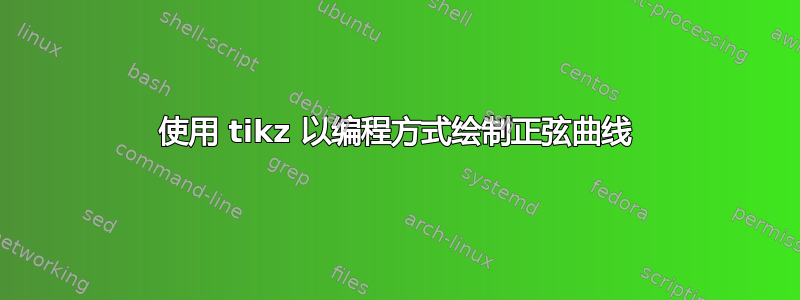
这是正弦波的八次完整振荡:
代码如下:
\documentclass{standalone}
\usepackage{tikz}
\begin{document}
\begin{tikzpicture}
\draw[gray!20] (0,-2) grid (32,2); %Grid
\draw[black,-] (0, 0) -- (32,0); %X-Axis
\draw[black,-] (0,-2) -- (0 ,2); %Y-Axis
\draw[blue] (0 ,0) %Origin
%Sine-Wave%%%%%%%%%%%%%%%%%%%%%%%%%%%%%%%%%%%%%%%%%%%%%%%%%%%%%%%%%%%%%%%%%%%%%%%%%%%%%%%%%%%
sin (1 ,2) cos (2 ,0) sin (3 ,-2) cos (4 ,0) sin (5 ,2) cos (6 ,0) sin (7 ,-2) cos (8 ,0)
sin (9 ,2) cos (10,0) sin (11,-2) cos (12,0) sin (13,2) cos (14,0) sin (15,-2) cos (16,0)
sin (17,2) cos (18,0) sin (19,-2) cos (20,0) sin (21,2) cos (22,0) sin (23,-2) cos (24,0)
sin (25,2) cos (26,0) sin (27,-2) cos (28,0) sin (29,2) cos (30,0) sin (31,-2) cos (32,0);
\end{tikzpicture}
\end{document}
我的问题不一定是关于正弦波或三角函数。我更关心的是使用 LaTeX 编写算法并将其当做真正的编程语言来使用。
注意到我手动指定了 32 对坐标,并引用了sin& cos16 次,只是为了绘制同一条曲线的 8 次迭代吗?比如说,我想生成一系列不同的独立波形,这些波形与这个波形相似但不同。我不想每次都输入每一个坐标,我想让所有无聊、重复的东西自动化。
现在,我不需要有人帮我画图并转储代码,而是分享和解释你可以用编程方式解决它的不同技巧和技术。我们中的许多人不知道我们可以使用哪些工具。目标是向我们其他人展示如何自己处理和解决这些问题,以便我们可以学会自己做。
答案1
为了绘制正弦函数,我将使用plot宏:
\documentclass[tikz, margin=3mm]{standalone}
\begin{document}
\begin{tikzpicture}
\draw[gray,thin] (0,-2) grid[xstep=pi/2,ystep=1] (8*pi,2); %Grid
\draw (0, 0) -- (8*pi,0) %X-Axis
(0,-2) -- (0 ,2); %Y-Axis
% Sine-Wave, \x r means to convert '\x' from degrees to radians
\draw[blue] plot[domain=0:16*pi, samples=320] (0.5*\x,{2*sin(\x r)});
\end{tikzpicture}
\end{document}
编辑:
TikZ 提供了用于绘制函数的宏
plot。其用法在章节中描述。22.5 绘制函数,TikZ 和 PGF 手册(版本 3.1.4a)第 339 页。由于我以弧度定义域,因此
sin函数的参数添加r:sin(\x r),这将函数参数从弧度转换为角度。在定义域时使用了一个小技巧。由于八个函数间隔的域比文本宽度长,因此域缩短为一半(为
16*pi`` and the same time the widths of intervals is shortened to0.5*\x`(这使函数频率翻倍):
\draw[blue] plot[domain=0:16*pi, samples=320] (0.5*\x,{2*sin(\x r)});
- 绘制的函数很平滑,我每弧度使用了 20 个样本(总共 320 个样本)
答案2
给出正弦波的频率、周期和振幅,并在pic设置中提供颜色选项。网格是根据频率、周期和振幅值绘制的。foreach循环tikzset从零开始,频率用绘制0 to f-1。绘制正弦波是基于 Ti钾z 基础知识。
\documentclass[tikz,border=10pt]{standalone}
\tikzset{%
pics/sw/.style args={color=#1,f=#2,p=#3,a=#4}{%
code={%
\def\f{#2}%Frequency
\def\p{#3}%Period
\def\a{#4}%Amplitude
\draw[gray!20] (0,-\a) grid (\p*\f,\a); %Grid
\draw[black,-] (0, 0) -- (\p*\f,0); %X-Axis
\draw[black,-] (0,-\a) -- (0 ,\a); %Y-Axis
\pgfmathsetmacro{\k}{#2-1}
\foreach \t in{0,1,...,\k}{
\draw[thick,#1] ({\t*\p},0) sin (#3/4+\t*\p,#4)cos(#3/2+\t*\p,0)sin(#3*3/4+\t*\p,-#4)cos(#3+\t*\p,0);%
}%
}
}
}
\begin{document}
\begin{tikzpicture}
\pic {sw={color=blue,f=8,p=4,a=2}};
\end{tikzpicture}
\end{document}
对于f=8和:p=4a=2\pic {sw={color=blue,f=8,p=4,a=2}};
对于f=4和:p=5a=3\pic {sw={color=red,f=4,p=5,a=3}};
附录: 向代码添加一些功能:
\documentclass[tikz,border=10pt]{standalone}
\tikzset{%
pics/sw/.style args={color=#1,f=#2,p=#3,a=#4}{%
code={%
\def\f{#2}%Frequency
\def\p{#3}%Period
\def\a{#4}%Amplitude
\draw[gray!50] (0,-\a) grid (\p*\f,\a); %Grid
\pgfmathsetmacro{\n}{#2*#3}
\foreach \x in{0,1,...,\n}{
\node at (\x,0)[below right]{\x};}
\draw[black,->] (0, 0) -- (\p*\f+1,0)node[above]{$x$}; %X-Axis
\draw[black,->] (0,-\a)node[left]{-$#4$} -- (0 ,\a+1)node[right]{$y$}; %Y-Axis
\node at (0,\a)[left]{$#4$};
\pgfmathsetmacro{\k}{#2-1}
\foreach \t in{0,1,...,\k}{
\draw[ultra thick,#1] ({\t*\p},0) sin (#3/4+\t*\p,#4)cos(#3/2+\t*\p,0)sin(#3*3/4+\t*\p,-#4)cos(#3+\t*\p,0);%
}%
\node at (\n/2,\a+1){$y=\sin\,x$};%
}
}
}
\begin{document}
\begin{tikzpicture}
\pic {sw={color=cyan,f=6,p=4,a=3}};
\end{tikzpicture}
\end{document}
答案3
一个非常粗糙的循环起点foreach。并不优雅(在我看来),但提供了一种可能性。
\documentclass{standalone}
\usepackage{tikz}
\begin{document}
\begin{tikzpicture}
\draw[gray!20] (0,-2) grid (32,2); %Grid
\draw[black,-] (0, 0) -- (32,0); %X-Axis
\draw[black,-] (0,-2) -- (0 ,2); %Y-Axis
%% incorporating @marmot's (user121799) suggestion
\draw[blue] foreach \x in {1,5,...,29} { ({\x-1} ,0) sin ({\x} ,2) cos ({\x+1} ,0) sin ({\x+2}, -2) cos ({\x+3} ,0)};
\end{tikzpicture}
\end{document}
尽管如此,我很确定你可以做得更多:)








